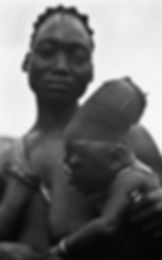The Sculpted Skull: Understanding the Skull Elongation Tradition of the Mangbetu People
- Daniel Holland
- Jun 15
- 4 min read

There is no singular standard of beauty. Throughout history and across continents, human beings have continually reimagined what it means to be beautiful. From the intricate tattoos of the Māori, to the neck rings of the Kayan women of Myanmar, to the contemporary era of cosmetic surgery, the human body has long been a canvas for cultural ideals. One of the most striking and lesser-known examples of this impulse is found among the Mangbetu people of the present-day Democratic Republic of the Congo (DRC): the practice of skull elongation, an artful transformation that once signified beauty, intellect and nobility.

A People of Art and Elegance
The Mangbetu occupy a region of north-eastern Congo and are celebrated not only for their elaborate music and distinctive visual art—like the famed Mangbetu harps, one of which once commanded a price of $100,000 at auction—but also for their uniquely sculpted skulls. Visitors and early European photographers in the late nineteenth and early twentieth centuries often fixated on this dramatic feature, photographing Mangbetu women in profile to highlight the high, sloping forehead that crowned their identity.
Lipombo: The Art of Shaping Thought
The practice, known as Lipombo, was rooted in an ancient understanding of both biology and aesthetics. Families of higher social standing would begin binding the heads of their newborn daughters about a month after birth. At this stage, an infant’s skull is naturally malleable due to the soft fontanelles between cranial bones, which allow the rapidly growing brain to expand. By tightly winding a cloth bandage around the head, caregivers could gently guide the skull into an elongated form over the course of roughly two years.

More than just a marker of class, the elongated skull became deeply intertwined with concepts of beauty, prestige and even intellect among the Mangbetu. When the girls matured, they accentuated the effect further by styling their hair around a woven basket-like frame, securing it with decorative pins. This coiffure, combined with the high forehead, conferred a regal bearing that was admired both within and beyond Mangbetu society.

A Practice in Global Context
Skull elongation, or more formally artificial cranial deformation (ACD), is far from exclusive to the Mangbetu. Archaeological evidence suggests that ACD appeared independently in various civilisations. It has been documented in ancient Egypt, practised among the Maya of Mesoamerica, and noted in parts of mediaeval France. Some scholars argue that these practices emerged organically rather than through cultural transmission, each society reaching similar aesthetic ideals due to the shared physical properties of the human skull in infancy.

In Africa, however, the Mangbetu stand largely alone in this dramatic reshaping of the skull. In parts of West Africa, such as Ghana and Nigeria, a milder form of head moulding persists to this day. This contemporary variation typically involves gentle manual shaping using warm towels and pressure, often to correct perceived irregularities in a baby’s head shape, thus sparing the child from potential ridicule later in life.

Colonial Interference and Decline
European colonial authorities viewed practices like Lipombo through a paternalistic lens, often deeming them primitive or unhealthy. By the 1950s, under Belgian colonial rule, skull elongation was actively discouraged and eventually prohibited. Coupled with the increasing influence of Western beauty ideals and the missionary disdain for so-called ‘pagan’ customs, Lipombo gradually vanished from daily life. Today, it is rare to encounter an elderly Mangbetu woman who still bears this physical testimony to her community’s once widespread aesthetic tradition.

Nevertheless, the legacy of Lipombo persists in the Mangbetu’s sculptural and pictorial art. Statues, ceremonial vessels and even decorative household objects frequently depict the iconic elongated cranium. These artefacts now serve not only as cultural heirlooms but also as anthropological evidence of the Mangbetu’s ingenuity in harmonising the biological with the symbolic.

Medical and Ethical Debates
From a modern medical perspective, the practice of skull elongation is a subject of debate. While some paediatric specialists argue that altering the shape of the skull might impinge upon brain development—potentially affecting the lobes responsible for cognition, vision and motor skills—others maintain that, if done properly, the process does not significantly alter intracranial pressure or impede healthy brain function.

Crucially, the Mangbetu appeared to have an intuitive grasp of these biological constraints. The gradual pace and careful binding meant that the brain adapted to the skull’s shape rather than being compressed by it. It was this empirical wisdom, rather than formal anatomy or medical equipment, that enabled the custom to flourish for generations without widespread harm.

Reflections on Beauty and Identity
The story of Mangbetu skull elongation is more than a footnote in the catalogue of human body modification; it is a vivid reminder that beauty is never a fixed concept. Rather, it is an evolving dialogue between the body, the culture and the collective imagination of a people. While some may recoil at the thought of reshaping an infant’s skull, for the Mangbetu, this was a loving act—an investment in a child’s future status and grace.

Today, as societies worldwide debate the ethics of plastic surgery, body augmentation and even genetic editing, the Mangbetu’s Lipombo tradition invites us to consider the lengths to which humans will go to embody their ideals of beauty and identity. It challenges us to see body modification not merely as vanity, but as a deeply rooted expression of belonging, status and the human desire to shape not only one’s life but one’s very form.
Sources
Casey Golomski, Mangbetu Ethnography and Cultural Practices, University of Massachusetts
Enid Schildkrout, Body Decoration and Body Modification: Cultural Expressions of Identity
National Museum of African Art, Smithsonian Institution, Mangbetu Art and Identity
Robert Brain, The Decorated Body
African Art Museum collections, www.africa.si.edu
Medical discussions on ACD, Journal of Neurosurgery: Pediatrics






















